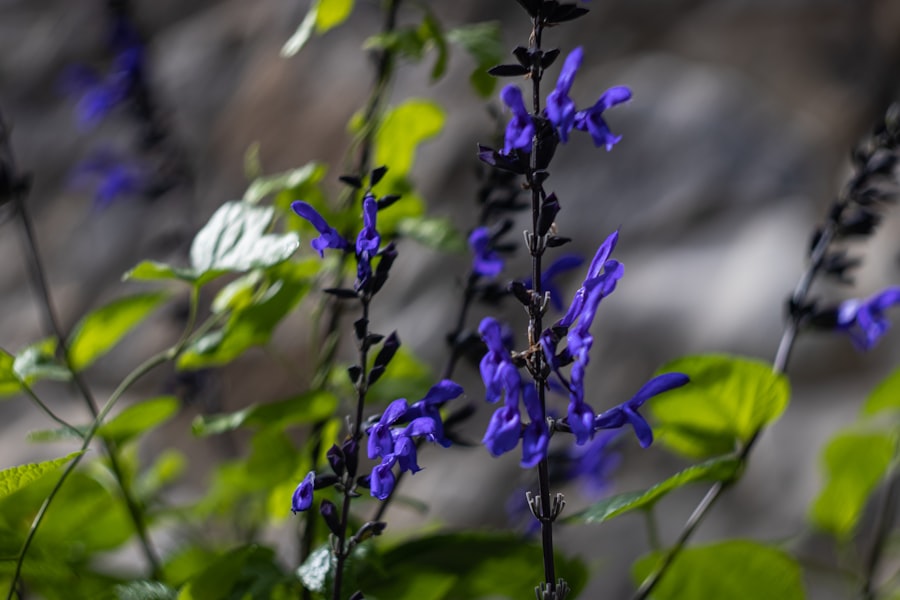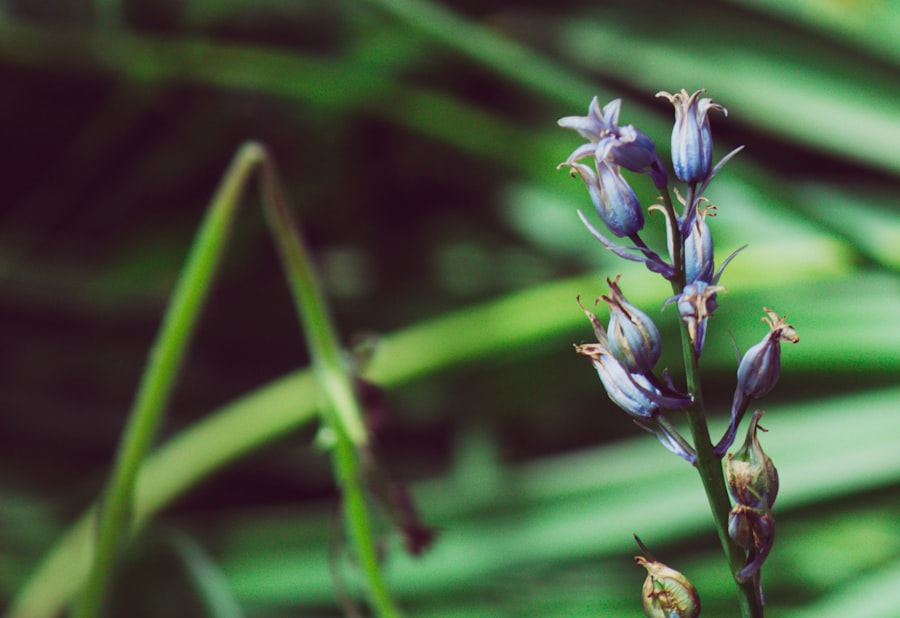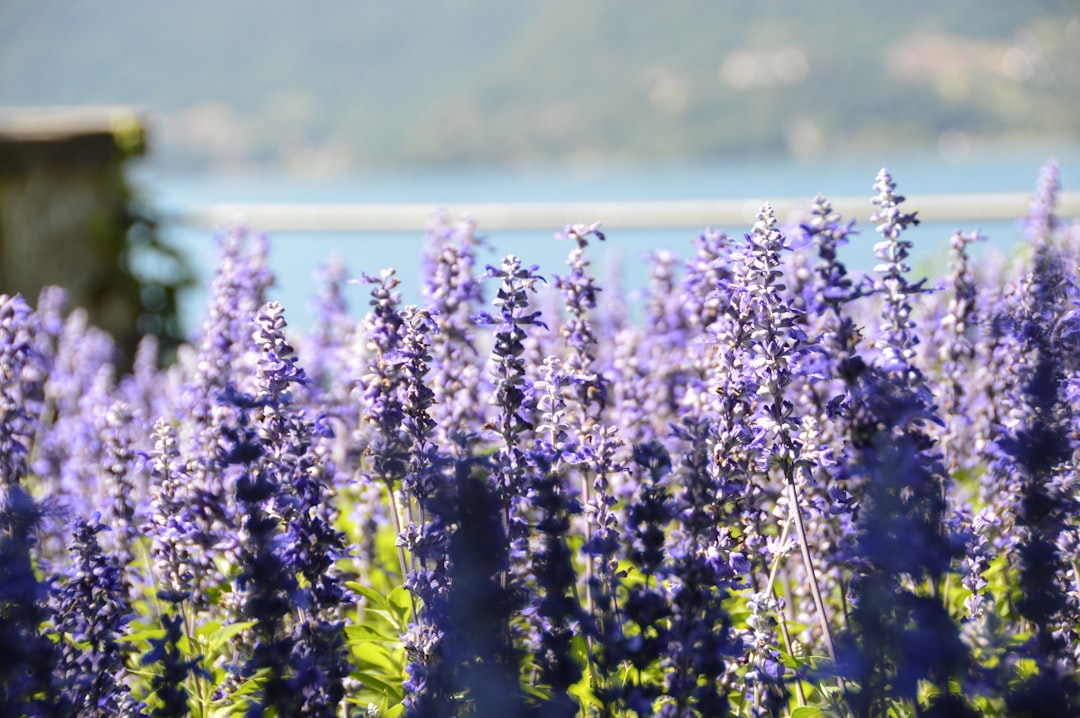Salvia, a genus belonging to the mint family (Lamiaceae), encompasses a diverse array of flowering plants, with over 1,000 species worldwide. This remarkable diversity allows for a wide range of colors, sizes, and growth habits, making salvia a popular choice among gardeners and landscape designers alike. The most commonly cultivated species include Salvia officinalis, known as culinary sage, and Salvia splendens, often referred to as scarlet sage.
These plants are not only valued for their ornamental beauty but also for their aromatic leaves and medicinal properties. The name “salvia” is derived from the Latin word “salvare,” which means “to save” or “to heal,” reflecting the historical use of various salvia species in traditional medicine. Many cultures have utilized salvia for its therapeutic benefits, including its anti-inflammatory and antimicrobial properties.
In addition to their medicinal uses, salvias are also known for attracting pollinators such as bees and butterflies, making them an excellent choice for eco-friendly gardens. With their vibrant blooms and resilience, salvias can thrive in a variety of conditions, making them a staple in both ornamental and functional gardening.
Key Takeaways
- Salvia is a versatile and low-maintenance plant that can thrive in various growing conditions.
- There are different varieties of salvia flowers to choose from, each with its own unique characteristics and growing requirements.
- Select a location with well-drained soil and plenty of sunlight for optimal growth of salvia plants.
- Prepare the soil by adding organic matter and ensuring good drainage to create the best environment for salvia to thrive.
- Follow a step-by-step guide for planting salvia flowers, ensuring proper spacing and depth for healthy growth.
Choosing the Right Variety: Different Types of Salvia Flowers
When selecting salvia for your garden, it is essential to consider the specific varieties that best suit your aesthetic preferences and environmental conditions. Salvia splendens is a popular choice for its bright red flowers that bloom throughout the summer, creating a striking visual impact in any landscape. This variety is often used in annual bedding displays and can be found in various colors, including pink, purple, and white.
Its compact growth habit makes it ideal for borders and containers. Another noteworthy variety is Salvia nemorosa, commonly known as woodland sage. This perennial species features spikes of blue to purple flowers that attract pollinators and provide a lovely contrast against its green foliage.
Salvia nemorosa is particularly valued for its long blooming period and drought tolerance, making it an excellent choice for low-maintenance gardens. For those interested in culinary applications, Salvia officinalis offers not only ornamental value but also flavorful leaves that can enhance a variety of dishes. Each variety of salvia brings unique characteristics to the garden, allowing gardeners to create diverse and visually appealing landscapes.
Selecting the Perfect Location: Ideal Growing Conditions for Salvia

Salvia plants thrive in full sun, requiring at least six hours of direct sunlight each day to produce their vibrant blooms. When selecting a location for planting salvia, consider areas that receive ample sunlight throughout the day. While some varieties can tolerate partial shade, they may not flower as profusely or exhibit the same vigor as those grown in full sun.
Additionally, salvia plants prefer well-drained soil, as they are susceptible to root rot in overly wet conditions. In terms of climate, salvia is adaptable to a range of environments but generally prefers warmer temperatures. Many species are hardy in USDA zones 5 through 10, making them suitable for a wide geographic area.
However, it is crucial to research the specific hardiness zone of the chosen variety to ensure successful growth. Wind protection can also be beneficial, as strong gusts can damage delicate flower spikes. By carefully selecting the right location with optimal sunlight and protection from harsh elements, gardeners can set the stage for healthy salvia growth.
Preparing the Soil: Tips for Creating the Best Growing Environment
Creating an ideal soil environment is critical for the successful growth of salvia plants. Start by testing the soil pH; salvia generally prefers a slightly acidic to neutral pH range of 6.0 to 7.0. If necessary, amendments such as lime can be added to raise pH levels or sulfur to lower them.
Additionally, salvia thrives in well-draining soil rich in organic matter. To achieve this, consider incorporating compost or well-rotted manure into the planting area to improve soil structure and fertility. Drainage is particularly important for salvia plants, as they do not tolerate soggy roots.
If your garden soil tends to retain water, consider creating raised beds or mounds to enhance drainage. Adding sand or perlite can also improve soil aeration and drainage capabilities. Before planting, ensure that the soil is loose and crumbly to facilitate root growth.
By preparing the soil with these considerations in mind, you can create an optimal growing environment that supports healthy salvia development.
Planting Salvia: Step-by-Step Guide to Planting Salvia Flowers
Once you have selected the right variety and prepared the soil, it’s time to plant your salvia flowers.
If you are starting from seeds, sow them indoors about 6-8 weeks before the last frost date or directly outdoors after the danger of frost has passed.
For transplants or nursery-bought plants, ensure they are acclimated to outdoor conditions before planting. To plant salvia, dig a hole that is approximately twice the width of the root ball and just deep enough to accommodate it without burying the crown of the plant. Space multiple plants according to their mature size; smaller varieties may need about 12-18 inches apart, while larger types may require up to 24 inches between them.
Gently place the plant in the hole and backfill with soil, ensuring there are no air pockets around the roots. Water thoroughly after planting to help settle the soil around the roots and promote establishment.
Watering and Fertilizing: Best Practices for Keeping Salvia Healthy

Watering Salvia
Proper watering practices are essential for maintaining healthy salvia plants. While salvia is drought-tolerant once established, young plants require consistent moisture during their initial growth phase. Water deeply but infrequently to encourage deep root development; this means allowing the top inch of soil to dry out between waterings.
Avoiding Overwatering and Fungal Diseases
Overwatering can lead to root rot and other fungal diseases, so it’s crucial to monitor soil moisture levels regularly. Fertilization should be approached with caution; salvia does not require heavy feeding and can thrive in average soil conditions.
Fertilizing for Blooming
A balanced fertilizer applied at half strength during the growing season can support blooming without promoting excessive foliage growth at the expense of flowers. Organic options such as compost tea or fish emulsion can also provide necessary nutrients while enhancing soil health. By adhering to these watering and fertilizing guidelines, gardeners can ensure their salvia plants remain vibrant and healthy throughout the growing season.
Pruning and Deadheading: How to Maintain Salvia Flowers
To keep salvia plants looking their best and encourage continuous blooming, regular pruning and deadheading are essential practices. Deadheading involves removing spent flowers before they set seed; this not only improves the plant’s appearance but also redirects energy toward producing new blooms rather than seed production.
In addition to deadheading, pruning can help maintain the shape and size of salvia plants. After flowering has finished in late summer or early fall, consider cutting back leggy growth or any stems that have become unruly. This rejuvenation pruning encourages bushier growth and can lead to more abundant blooms in subsequent seasons.
For perennial varieties like Salvia nemorosa, cutting back foliage in late fall or early spring can promote healthy new growth when spring arrives.
Dealing with Pests and Diseases: Common Issues and Solutions
While salvia plants are generally resilient, they can be susceptible to certain pests and diseases that may hinder their growth or diminish their beauty. Common pests include aphids, spider mites, and whiteflies, which can sap plant vigor by feeding on sap or causing stress through their presence. Regularly inspecting plants for signs of infestation is crucial; if pests are detected early on, they can often be managed through natural remedies such as insecticidal soap or neem oil.
Diseases such as powdery mildew or root rot may also affect salvia plants under certain conditions. Powdery mildew typically appears as a white powdery coating on leaves during humid weather; improving air circulation around plants by spacing them appropriately can help prevent this issue. Root rot often results from overwatering or poorly draining soil; ensuring proper drainage and allowing soil to dry out between waterings can mitigate this risk significantly.
By staying vigilant against pests and diseases, gardeners can maintain healthy salvia plants throughout their growing season.
Propagating Salvia: Tips for Growing Salvia from Seeds or Cuttings
Propagating salvia can be an enjoyable way to expand your garden without incurring additional costs from purchasing new plants. One effective method is seed propagation; collect seeds from mature flowers once they have dried on the plant but before they shatter onto the ground. Store seeds in a cool, dry place until you are ready to sow them indoors or outdoors according to your local climate’s timing guidelines.
Alternatively, cuttings offer another viable propagation method for many salvia species. To take cuttings, select healthy stems from an established plant during late spring or early summer when growth is vigorous. Cut a 4-6 inch section just below a leaf node and remove any lower leaves to prevent rot when placed in soil or water for rooting.
Dip the cut end in rooting hormone if desired before placing it in a well-draining potting mix or water until roots develop. With patience and care, propagating salvia through seeds or cuttings can yield new plants that flourish in your garden.
Overwintering Salvia: Preparing Salvia for the Winter Months
As winter approaches, preparing salvia plants for colder temperatures is essential for their survival and health in subsequent growing seasons. For perennial varieties that are hardy in your region, cut back spent foliage after frost has blackened it but leave some stems intact to provide winter interest and protection for emerging buds below ground level. Applying a layer of mulch around the base of these plants can help insulate roots against freezing temperatures while retaining moisture.
For tender varieties that cannot withstand frost, consider bringing potted salvias indoors before temperatures drop significantly or treating them as annuals by replacing them each spring. If overwintering indoors, place them in a bright location with moderate temperatures while reducing watering frequency since indoor conditions tend to be drier than outdoors during winter months. By taking these steps to prepare salvia for winter conditions, gardeners can ensure their plants emerge healthy and ready to thrive come spring.
Enjoying Your Salvia Garden: Tips for Maximizing the Beauty of Salvia Flowers
Creating a stunning salvia garden involves more than just planting; it requires thoughtful design and maintenance practices that enhance their natural beauty throughout the growing season. Consider incorporating salvias into mixed borders alongside complementary perennials such as echinacea or rudbeckia that bloom at different times for continuous color variation across seasons. The tall flower spikes of some salvia varieties provide vertical interest while shorter types fill gaps at ground level.
Additionally, utilizing salvias in containers allows for flexibility in design; they can be moved around as needed to create focal points on patios or decks while providing easy access for maintenance tasks like deadheading or watering. Grouping different varieties together based on color schemes or bloom times creates visual harmony within your garden space while attracting pollinators who appreciate diverse plantings. By implementing these strategies into your gardening practices, you can fully enjoy the vibrant beauty that salvia flowers bring to your outdoor spaces year after year.
If you’re interested in learning more about beautiful flowering bushes, check out this article for some inspiration on adding color to your garden. Additionally, if you want to explore other vibrant flower options, take a look at this guide to learn about different types of orange flowers. And if you’re looking for tips on caring for orchids, be sure to read this helpful article that covers common orchid diseases and how to prevent them.
FAQs
What is Salvia?
Salvia is a genus of plants in the mint family, Lamiaceae, which includes over 900 species of shrubs, herbaceous perennials, and annuals.
What are the different types of Salvia?
There are many different types of Salvia, including Salvia officinalis (common sage), Salvia splendens (scarlet sage), Salvia nemorosa (woodland sage), and Salvia divinorum (diviner’s sage), among others.
How do you grow Salvia from seeds?
To grow Salvia from seeds, start by sowing the seeds indoors in early spring. Use a well-draining potting mix and keep the soil consistently moist. Once the seedlings have developed several sets of true leaves, they can be transplanted outdoors.
What are the ideal growing conditions for Salvia?
Salvia plants prefer full sun and well-drained soil. They are drought-tolerant once established and generally do not require much maintenance.
How do you care for Salvia plants?
Caring for Salvia plants involves regular watering, especially during dry periods, and deadheading spent flowers to encourage continuous blooming. Additionally, pruning the plants in early spring can help promote bushier growth.
Are there any pests or diseases that affect Salvia plants?
Salvia plants are relatively resistant to pests and diseases. However, they may occasionally be affected by aphids, spider mites, or powdery mildew. These issues can typically be addressed with insecticidal soap or fungicides, if necessary.
When is the best time to plant Salvia?
The best time to plant Salvia is in the spring, after the last frost has passed. This allows the plants to establish themselves before the heat of summer.

